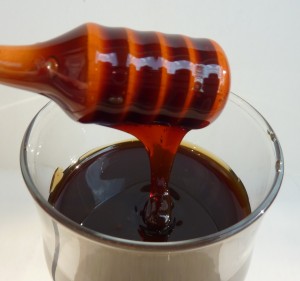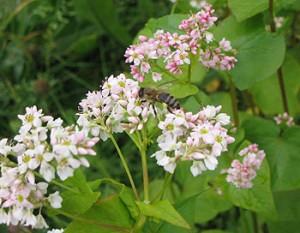Buckwheat flowers are very fragrant and are attractive to bees that use them to produce a special, strongly flavored, dark memorable honey. It can range in color from dark yellow to dark brown, with a slight reddish tinge. It has a sharp spicy aroma and taste with bitter tones. The scent of wood and clay is characteristic, with a powerful malty, molasses flavor. It is said to leave a tickle in the throat.
It can be used for cooking poultry, foie gras, pork or beef. Also in sauces and over ice cream. In desserts as a sugar replacement and especially with strong cheeses. Buckwheat honey is the key ingredient used to make gingerbread (spice-bread or pain d’épices) originating in Brittany, France, where buckwheat plays an important cultural role. Also from Brittany comes a style of mead (honey wine) called Chouchen made from Buckwheat honey and cider. It is also finding popularity with mead brewers in America who like the strong flavor and slightly nutty bitter taste.
Darker honeys are rich in antioxidants. Also rich in iron and minerals, this honey is renowned for its a restorative properties and toning. It has been shown to be more effective than dextromethorphan (DM) as an cough suppressant for children. A spoonful at night can relieve heartburn and calm the stomach. Study results for wound care are most promising, and indicate buckwheat honey to be an effective antimicrobial wound-healing product. Buckwheat honey has been shown to be effective in reducing oxidative stress, which can result in significant damage to cell structures. The major antioxidant properties in buckwheat honey derive from its phenolic constituents, which are present in relatively large amounts. Its phenolic compounds may also exert antibacterial activity.
Buckwheat is a hardy wild, broad leaf, plant crop. Contrary to what most people think, it is not a cereal grain nor a grass, it is a fruit seed belonging to the Polygonaceae family which includes rhubarb and sorrel. The seed is three-sided with sharp angles, resembling a Beech-nut. In Dutch it was called “Boek-weit” meaning ‘Beech-wheat”, thus the name “Buckwheat”. It is a suitable substitute for grains for people sensitive to gluten.
It is believed to have originated in the area of Lake Baikal in Siberia, in the Himalayas, and in Manchuria. It is also used in Eastern Europe (kasha and blintzes), Japan (soba noodles) and India (kuttu ki puri and kuttu pakoras). The fruit seed of the buckwheat plant has been long valued in both East and West as an important food.
Buckwheat Festival: Come out and celebrate this ancient, traditional crop.
- Preston County Buckwheat Festival, Kingwood, West Virgina, U.S., at the end of September. Find buckwheat honey and enjoy their famous buckwheat cakes served all over the county.
Latin Name: Common Buckwheat: Fagopyrum esculentum Moench usually grown at lower altitudes. Tartary Buckwheat: Fagopyrum Tataricum usually grown at higher alitudes because of frost tolerance.
Translations: Russian: мед гречишный; Polish: Miód gryczany; French: Meil de Sarrasin; Italian: Miele di Grano Saraceno
Honey Origin: The U.S.S.R., China, Japan, Poland, Canada, Brazil, U.S., South Africa. and Australia
Credit: Photo by Leo Michels – Source: www.imagines-plantarum.de public domain image





Hey guys – I write a weekly beekeeping blog post for HGTV Gardens. Mind if I use the buckwheat honey pic on this page in an upcoming post? I’ll link back and credit. Here’s my info: https://blog.hgtvgardens.com/author/kwalters/ Thanks! Kelley
Hi Kelley:
Please feel free. I would appreciate a link or attribution note.
…Scott
Hi
We’ve never had buckwheat honey until my wife brought home a gallon of it. One taste and we knew we were in for a challenge. A month later we still cannot get used to it. The kids refuse to eat it and we think it’s causing us diarrhea. The stuff seriously smells and tastes like a soiled diaper. Does any of this sound familiar? Is this what it typically smells like? If so I’ll do my best but if not please let me know. We have a whole gallon!
Hi Andy:
What a story! As dark buckwheat honey is one of my favorites, I am sad to hear of your predicament. It IS strong, but “soiled diapers” is a little too strong to be the predominant aroma.
My advice? Throw it away and buy some more! This time try a taste first… something I usually do, but just to sample a lot of honeys, not to test its eatability.
Best,
Scott